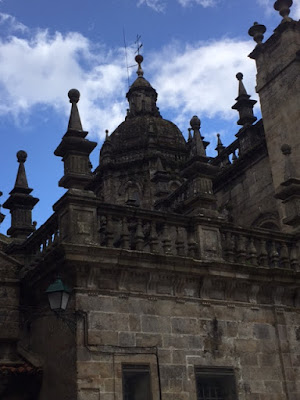I'm finally getting around to writing about the Cathedral of Santiago de Compostela. It is, after all, the reason for the Camino. Just to recap, James, along with his brother John, were two of the 12 apostles and also possible relatives of Jesus. Jesus nicknamed them "Sons of Thunder." James is allegedly buried in this cathedral.
The story about James and the Cathedral itself are both very complicated. Here he is above as an Apostle, one of three identities he has at the Cathedral. James supposedly came to Spain to evangelize the pagans. He returned to Jerusalem and was killed by Herod in 44, the first of the apostles to be martyred. His disciples brought his body back to Spain (some versions say in a stone boat) to be buried. His grave was lost for 800 years and then discovered by a hermit, who was led there by a star. Successive churches were built on the site and pilgrims started coming. The current church was consecrated in 1211. But the Cathedral of Santiago de Compostela has been a work in progress for centuries.
Here is basically what the Cathedral looks like today from its most well known side on the west, opposite the altar.
Here is the view we had. As you can see, major renovations. But this isn't what I mean about the Cathedral being a work in progress. It started out as a Romanesque Cathedral.
Here are some of the simple, even stark, Romanesque arches and pillars. But then the Gothic and the Baroque styles came along and they were incorporated into the Cathedral.
I'm pretty sure this is Gothic. And the facade on the front of the church in the postcard above is Baroque.
Here are some other views of the outside of the Cathedral. Above is the side that faced our hotel. You can see John and Luke walking across the plaza. Each of the four sides of the cathedral has a facade with artistically important stone carvings. Each side of the Cathedral also fronts a plaza.
Our guide Pedro is in the huge Plaza del Obradoiro, getting ready to take us into the Cathedral Museum, which is in the Cathedral.
The clock tower. Are you noticing the overcast skies in these photos? For most of our time in Santiago it rained or looked like it was going to rain. The climate in Galicia is much like the northwest U.S. We were fortunate to have such sunny weather for the nine days we walked.
Here's some blue sky.
Above in the middle is St. James in the second of his identities as a pilgrim. He is flanked by his two disciples, Theodore and Athanasius, who were also buried with him.
Another view.
Above is the only facade of the Cathedral that is still partially in its original state.
These stone figures were carved by Master Mateo, the sculptor who created many of the statues and carvings in the Cathedral.
The statue of the blind-folded woman on the pedestal represents blind faith.
Moving to the interior of the Cathedral. Here is the nave. It is in the simple, austere Romanesque-style. The gold at the end is the altar. It strikes me just now as I type this, that this layout is a good metaphor for life and eternal life. More on the altar in a bit.
Some of that good Galician granite.
The third identity of St. James in the Cathedral is that of Moor (Muslim) slayer. Part of the devotion to St. James stems from the inspiration people took from him in defeating the Muslims. (What we know of as Spain was ruled by Muslims for about 700 years) This role of St. James is downplayed; in the statue above, flowers cover (not quite) the bodies of Muslims that St. James is dispatching.
Our first look at the Cathedral came several days ago when our group had Mass in the Chapel of El Pilar, one of about 15 chapels in the Cathedral. Above is the Chapel of the Christ of Burgos.
Here is the Chapel of Mondragon from 1526. It was a little disillusioning when our guide Pedro told us that nobles and others had some of the chapels built so that they could be buried there, near the greatness of St. James.
Here are some closer views of the golden, baroque altar.
Above is the botafumeiro. At special Masses a few times a year, it is filled with incense and swung back and forth in a 180 degree arc across the transept on long ropes. This happened on Ascension Thursday while we were in Santiago de Compostela.
Than another set of steps takes us down below the altar where rests the remains of St. James and his two disciples. Pilgrims can kneel in front of the gate and say a prayer.
This is all very interesting and somewhat beautiful and prayerful to me, but I am still trying to figure out if there was anything special I was supposed to learn or take away from this pilgrimage.


























No comments:
Post a Comment